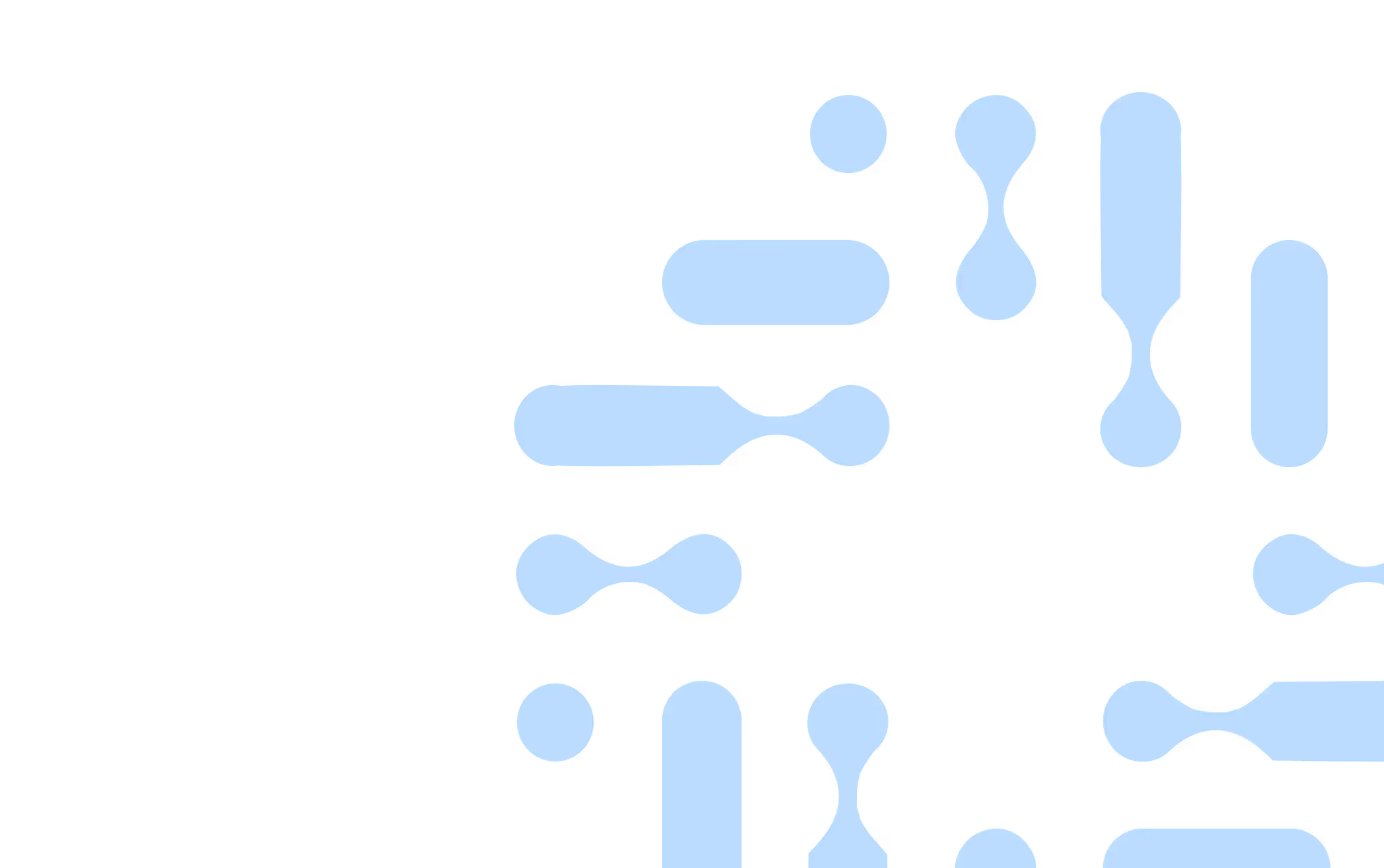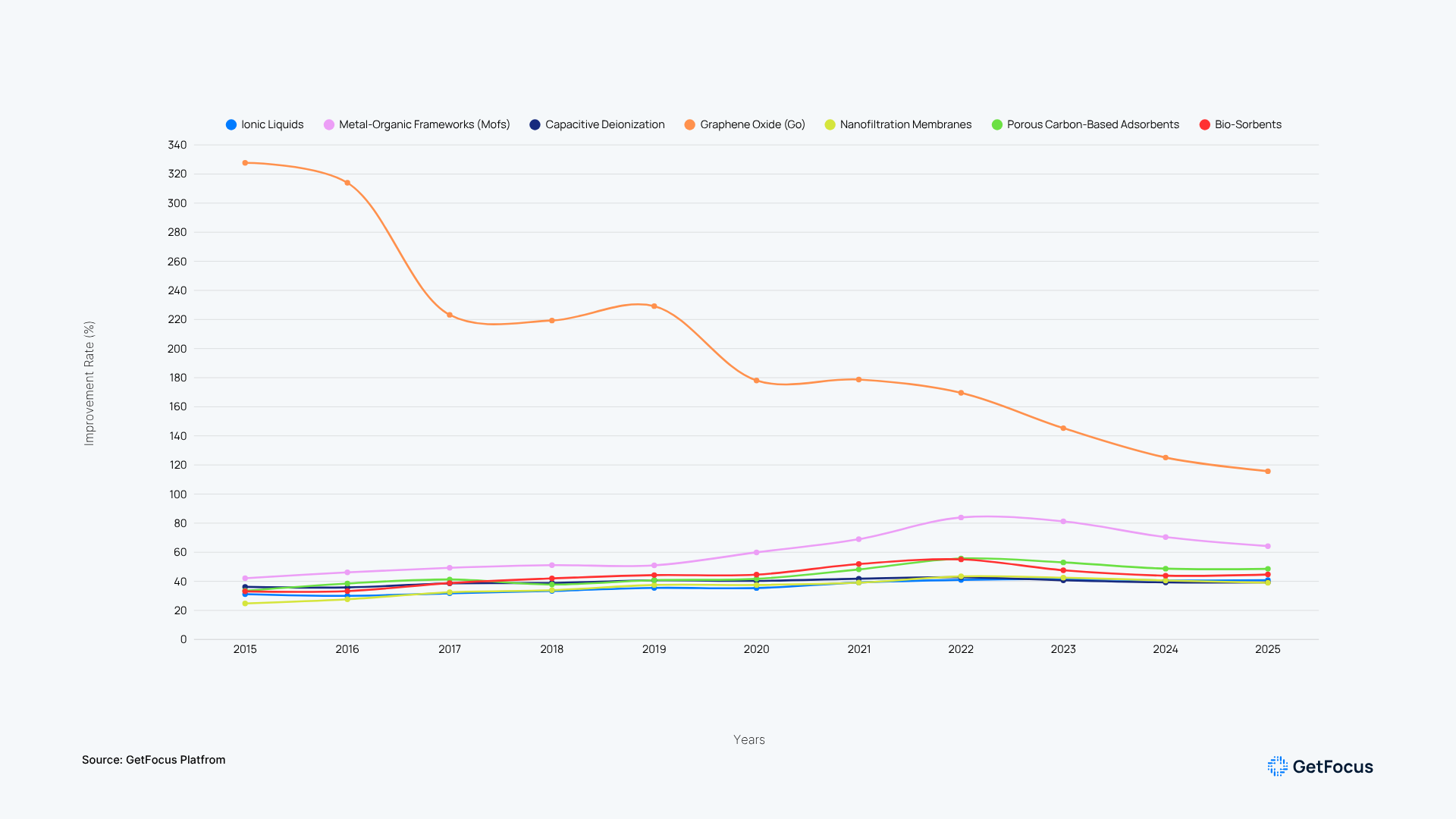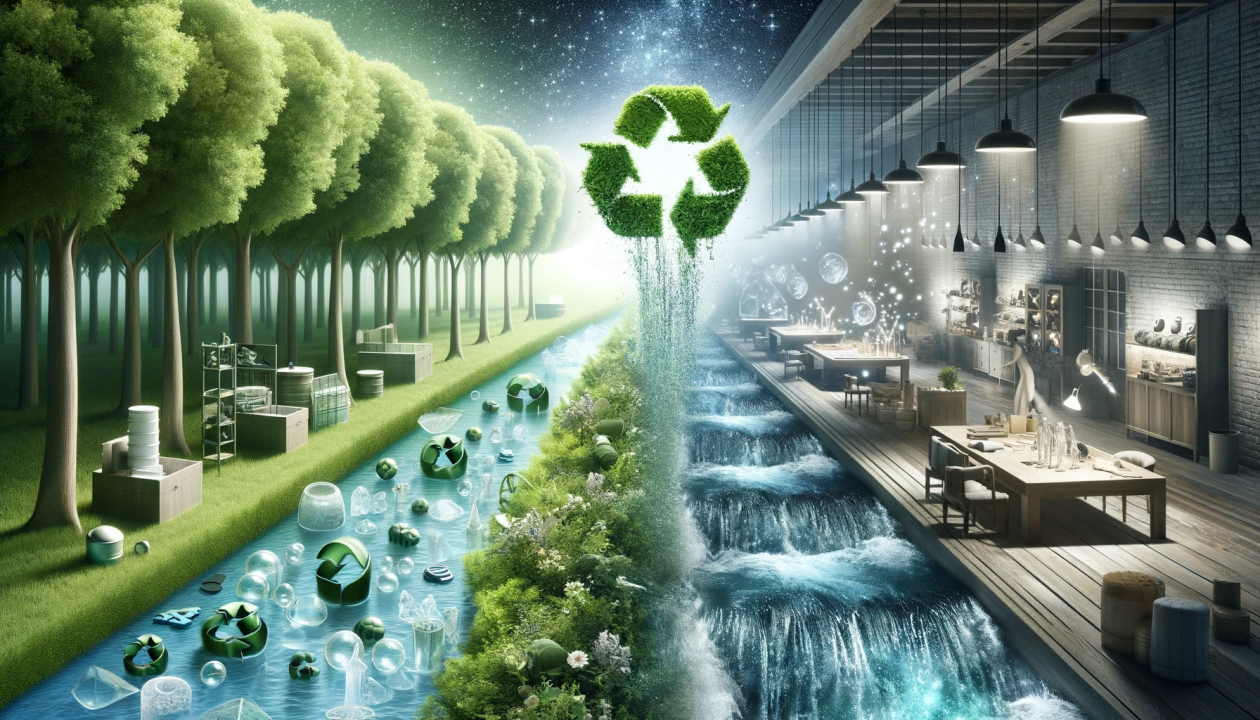Top 5 Disruptive Technologies in Direct Lithium Extraction

Direct Lithium Extraction (DLE) represents a fundamental shift from traditional lithium mining methods. While conventional approaches rely on massive evaporation ponds that consume up to 65% of regional water supplies or hard rock mining requiring over 115 acres per 1,000 metric tons of lithium carbonate equivalent, DLE technologies promise faster, cleaner, and more modular lithium recovery directly from brines.
GetFocus analysis, based on proprietary forecasting methodology inspired from MIT research, reveals that certain DLE technologies are improving at rates that position them to completely reshape the lithium supply chain.
Here are five technologies that stand out as the most disruptive forces:

1. The Performance Leader: Graphene Oxide (GO) Composites
Graphene oxide composites demonstrate the highest improvement rate among all DLE technologies at approximately 145% annually. These 2D nanomaterials offer exceptional lithium-binding potential and remarkable compatibility across multiple platform types.
GO composites can be integrated into membranes, adsorbents, and electrodes simultaneously. Their high surface area and excellent conductivity make them ideal for selective lithium capture when functionalized with appropriate binding groups. The materials can be tailored for different brine chemistries and easily regenerated under mild conditions.
However, GO composites face challenges with restacking and membrane fouling. Their synthesis and long-term performance optimization remain under development, contributing to their current Technology Readiness Level of 5.
The innovation landscape reveals that China dominates GO composite innovation, accounting for approximately 77% of global graphite production - the primary raw material for graphene production. Companies like Nanotek Instruments lead with 22 patent families, while the Chinese Academy of Sciences holds 12 families.
2. Precision Engineering: Metal-Organic Frameworks (MOFs)
MOFs represent the second-fastest improving DLE technology with an 81% annual improvement rate. These materials offer ultra-high surface area and highly customizable pore chemistry that enables precise lithium selectivity in both adsorption and membrane applications.
MOFs can be designed with specific pore structures and functional groups to enhance lithium-ion sieving capabilities. Their highly selective and tunable nature makes them particularly effective for complex brine chemistries with high impurity concentrations.
The synergy between MOFs and GO composites creates particularly powerful opportunities. MOFs can be effectively embedded into GO-based membranes, combining MOFs' selective pore structures with GO's mechanical strength and large surface area.
Current limitations include water and thermal stability issues, along with high synthesis costs that limit widespread deployment. These challenges keep MOFs at Technology Readiness Level 4, though their rapid improvement trajectory suggests these barriers are being actively addressed.
China also leads MOF innovation through established research institutions focused on advanced materials, while companies like EnergyX in the United States utilize MOF nanoparticles in their proprietary LiTAS™ technology.
3. Capacitive Deionization (CDI): Mechanical Simplicity
CDI systems achieve a 43% improvement rate while offering significant advantages in mechanical simplicity and scalability. These systems use pairs of porous electrodes with low-voltage operation, making them easier to scale and adapt compared to more complex electrochemical architectures.
[Electrochemistry] principles show that CDI enables low-energy separation using electric fields, particularly suited for low-concentration brines. The technology's modular nature allows for easy adaptation to different flow rates and brine types.
CDI outperforms both redox-mediated systems and electrochemical ion exchange by significant margins. This advantage stems from the technology's straightforward architecture and proven scalability in adjacent applications.
The main challenge lies in developing lithium-selective electrode materials, as performance can decline in brines with high ionic strength or fouling agents. Despite these limitations, CDI maintains a Technology Readiness Level of 6.
4. Nanofiltration Membranes: The Rising Performer
Nanofiltration membranes have recently surpassed composite membranes in improvement rate, reaching 44% annually. This technology's maturity in adjacent industries, particularly water treatment, has enabled faster material translation and system integration in DLE applications.
[Membrane science] shows that recent advances in thin-film fabrication, pore size control, and anti-fouling coatings drive this performance uptick. These membranes effectively remove divalent ions like Mg²⁺ and Ca²⁺, enriching lithium concentration in pre-treatment stages.
While not inherently lithium-selective, nanofiltration membranes require downstream integration for actual lithium recovery. Their primary value lies in brine conditioning and preparation for subsequent selective extraction steps.
The technology benefits from established manufacturing processes and reaches Technology Readiness Level 7, making it one of the most commercially ready options among advanced DLE technologies.
5. Bio-Sorbents: Sustainable Innovation
Bio-sorbents currently represent the fastest-improving biological DLE technology with a 55% improvement rate. These materials utilize functionalized natural substances like chitosan, cellulose, and biomass to improve lithium binding, stability, and scalability.
[Biotechnology] approaches show particular appeal for low-cost, low-footprint extraction systems. The materials are biodegradable and can be engineered for lithium adsorption with minimal environmental impact.
Recent innovation focuses on functionalizing natural materials to enhance lithium binding while maintaining their sustainable characteristics. This development trajectory suggests bio-sorbents may evolve from experimental curiosities into viable solutions for environmentally conscious lithium sourcing.
Current challenges include lower selectivity and mechanical durability compared to synthetic adsorbents, especially under harsh brine conditions. These limitations keep bio-sorbents at Technology Readiness Level 5.
Why These Technologies Are Disruptive
Each technology disrupts traditional lithium extraction through distinct mechanisms. GO composites and MOFs leverage [nanotechnology] to achieve unprecedented selectivity and efficiency rates that traditional materials cannot match. Their combination potential creates hybrid systems that capitalize on both materials' strengths.
CDI disrupts through operational simplicity, offering modular scalability that traditional electrochemical methods lack. Nanofiltration membranes disrupt by bringing mature manufacturing capabilities to an industry dominated by experimental approaches.
Bio-sorbents represent a completely different disruption model - challenging the industry's reliance on synthetic materials through sustainable alternatives that improve rapidly in cost-effectiveness.
The improvement rate analysis reveals that these technologies are not just incremental advances but represent fundamental shifts in how lithium can be extracted. With GO composites improving at 145% annually and MOFs at 81%, traditional methods cannot match these performance trajectory curves.
Strategic Implications
The data reveals that Direct Lithium Extraction stands at the crossroads of technological innovation and strategic necessity. With lithium demand accelerating and environmental standards tightening, the pressure to find cleaner, faster, and more scalable extraction methods continues intensifying.
For organizations considering DLE adoption, the evidence suggests focusing on the fastest-improving technologies like GO composites and MOFs, while monitoring regulatory momentum that increasingly favors low-footprint, water-efficient lithium recovery methods.
The convergence of these five disruptive technologies creates opportunities for hybrid approaches that could achieve performance levels impossible with traditional methods alone.
This analysis is based on comprehensive patent data analysis and improvement rate forecasting. For detailed methodology, complete technology assessments, and strategic implementation guidance, access the full research report.
More articles like this

A look into the future: BEV or FCEV—What AI has to say
AI-driven insights reveal why LFP batteries paired with graphene-coated silicon anodes are set to dominate EVs. This report outlines the breakthrough in energy density, Europe’s lag in adoption, and what automakers must do now to stay competitive in the global electric vehicle race.
Odin Platform Update – New Features & Improvements
We’re thrilled to introduce a range of new features and improvements on the Odin platform, designed to make your research and innovation process even more seamless. From chatting with up to 1,000 patents at once, to clickable patent links, complete patent references, and enhanced control over patent chats—this update is packed with powerful tools. Plus, our new Tracking Workflows feature helps you stay on top of critical changes in your patent sets effortlessly. Read the full post to explore how these updates can supercharge your work!

The Complex Challenge of Material Sourcing in Luxury Goods
The luxury goods sector, known for its stringent quality standards and opulent appeal, faces a daunting challenge in aligning with environmental sustainability, particularly in meeting Scope 2 and 3 emissions criteria. These scopes, part of the Greenhouse Gas (GHG) Protocol, extend beyond direct emissions (Scope 1) to include indirect emissions from purchased energy (Scope 2) and all other indirect emissions across a company's value chain (Scope 3).
Reach out to us!
Start a conversation. We are happy to help.
.svg)




